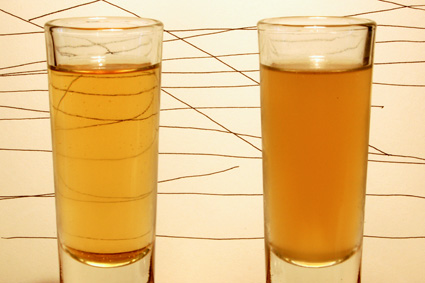Molecular gastronomy: cooking for the gadget- and science-obsessed. Cool, complicated, and making use of anything and everything in the race to be different. So, for the most part, not the sort of cooking any of us do at home.
Exception: gelatin clarification, as explained by Harold McGee in last week's New York Times. It's slow - which is why I'm writing about it nearly a week after the article - but remarkably effective. For example:

On the right, unclarified duck stock. On the left, the same stock after the clarification. Pale, clear, and with a more intense flavor. It's a trade-off for the lack of body, of gelatin, which served as the filter.
So, yes, it works. Well, and without much effort - though I do find that the process works better in a slightly warmer environment than my refrigerator, which I keep cool enough that the stock was quite slow to melt. Things moved along much better once I took to transferring the straining consommé to an insulated cooler with an ice pack, replacing it every so often (and keeping it all in the refrigerator when I wasn't around to keep tabs on it).
Next step: creating consommés out of unusual ingredients. In addition to their uses in cooking - broths, poaching liquids, etc. - they'd be perfect for infusing flavors into new places. Sorbets with flavors beyond fruit juice and infused herbs. Brilliantly clear cocktails - the Bloody Mary, the Bellini - with traditional or new flavor combinations; it's like creating the nonalcoholic equivalent of homemade bitters or vermouth. Breads - from crusty loaves to tender crepes - that don't have to sacrifice texture to get aromas of fruits, nuts, or cheeses. In essence, any place that water would go, there's now an opportunity to add another layer of flavor.
If only I had another refrigerator and freezer.

1 comment:
Post a Comment